|
Comparo Review:
Westland Wyvern S.4
Classic Airframes vs.
Dynavector plus Compass Rose Resin
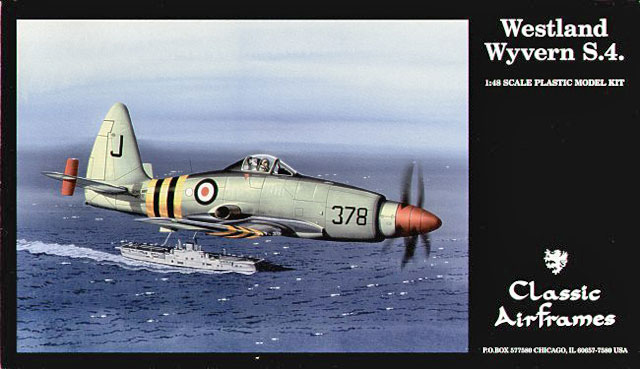
| Brand: |
Scale: |
Medium: |
Price and
Source: |
| Classic
Airframes |
1/48 |
Injection
moulded including resin resin details. |
Purchased for
USD$54.95 in 2005 from King's Hobbies |
Dynavector
plus
Compass Rose Detail Set |
1/48 |
Multimedia
kit (vacform main components plus white metal details).
Compass Rose detail set in resin |
Purchased for
USD$31.00 in 1994 from Precision Enterprises Ltd. Current
price on Hobbylink Japan 7200 yen (approx. USD$70.00).
Aftermarket resin detail set by Compass Rose, USD$29.95 |
| Airwaves wing
fold set |
1/48 |
Photo-etched
brass |
Purchased
direct from manufacturer |
by
"Bondo" Phil Brandt

Classic
Airframes' 1/48 scale Westland Wyvern is available online from Squadron
The short-lived Westland Wyvern has, some
fifty years later, become quite a modeling cult item, way back with the
1/72 Frog release, much later with the Dynavector multimedia offering,
and now with the Classic Airframes injected version.
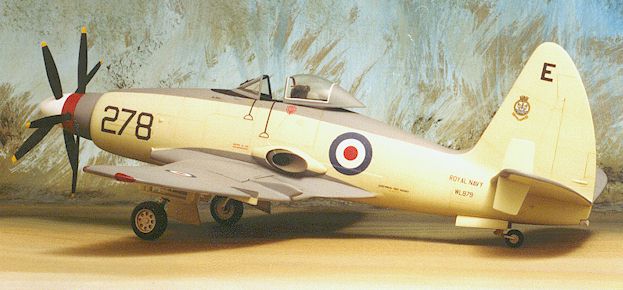
Dynavector's 1/48 scale Wyvern
built in 1996 by the late Anthony Butters.
Anthony's
construction article may be seen elsewhere on HyperScale
Perhaps the cachet of this big FAW fighter
is the mean, purposeful countenance of that huge spinner and
contra-rotating prop assembly, the turbo engine that drives it, and the
huge vertical fin. For this modeler, all these plus those neat black and
chrome yellow Suez stripes do it in spades!
The procrastination light has been glowing
over the Bondo Industries stash of Dynavector kits--the TSR.2 and Sea
Vixen excepted--for so long that it's about ready to burn out. And, this
curmudgeon's reward for that lack of action is a spanking new
injected--with resin detail parts--Wyvern, an industry first in 1/48, by
"Uncle" Jules Bringuier, forward-looking honcho of Classic Airframes.
Although modeling science does march on, I thought that since the middle
aged Dynavector kit and Compass Rose detail set are still available in
some quarters, it might be instructive to do a one-on-one comparison,
plastico a plastico, if you will.
I need to mention here that the Compass
Rose masters were done by legendary aftermarket resin guru Roy
Sutherland. Translation: this set is not, as they say in Modeldad's New
York vernacular, chopped liver! The following evaluations don't rate
construction procedures--obviously quite different--until the article's
end.
Molding
Note: In the following photos gray
resin=Classic Airframes; yellow resin=Dynavector.
The Classic Airframes (CA) molding is very clean and crisp, with
slightly aggressive engraving, virtually no flash, small spigots and
glossy surfaces (in comparison with the textured "glass-beaded" look
currently produced by many French and central European manufacturers.
The kit's main components are bereft of any locating pins, which
actually can be a benefit when aligning wings and fuselages. The CA
moldings have one major sink area: the droptank pylons.
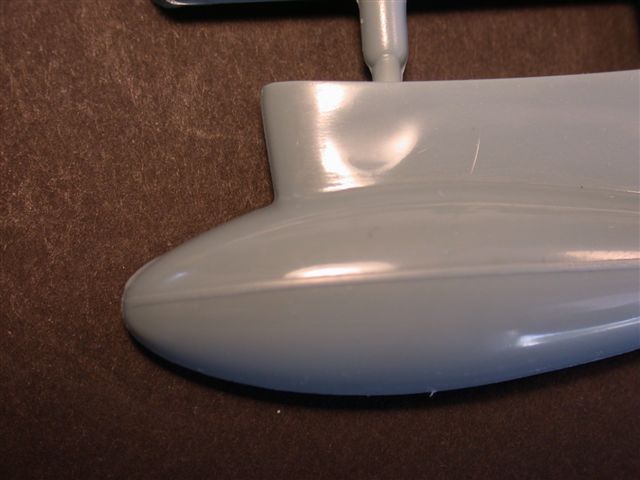
The Dynavector components are arguably the
best vacuforms ever done, of relatively thick plastic with exceptionally
fine engraving that is easily the equal of Tamiyagawa. Some corner
detail is not as sharp as injected due to the molding process itself,
not any flaw in the master. The Compass Rose set, however, levels the
playing field by replacing most of the above "soft" areas (speedbrakes,
wing root air intakes) with sharply detailed resin add-ons.
Verdict: A tossup
Cockpits and Canopies
The CA Wyvern features a resin tub and smaller components, all very well
done; the seat IMO is exceptional, with a veritable forest of cast-in
harnesses and belts just begging for wash application. Unfortunately, no
sidewall detail is included, and locating the tub within the smooth
inner walls of the fuselage is strictly up to the modeler. The
instrument panel is resin with the customary depressed circles to
represent individual gauges. The gunsight casting is so close in detail
to that of the Compass Rose one, that I can't tell them apart! The
canopy is conveniently two-piece, clear, but slightly thick.
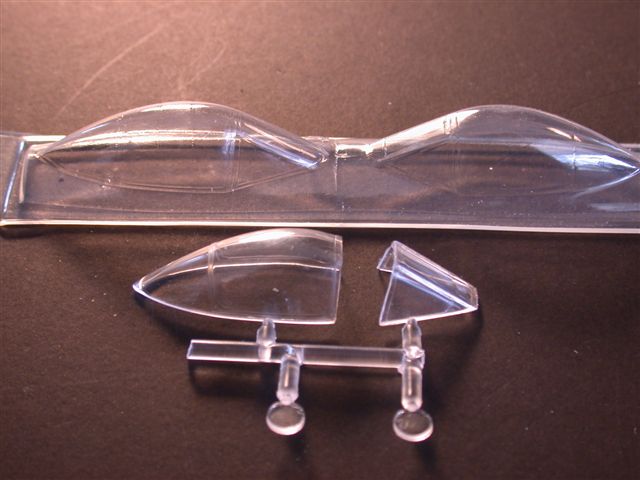
The OOB Dynavector Wyvern uses a vac'ed tub with add-on cast metal
consoles, instrument panel and fairly plain ejection seat (no harnesses
and belts). This is the point at which the Compass Rose detail set comes
into its own, replacing the entire Dynavector cockpit with a highly
detailed resin tub, a seat equal to the one by CA (a color photo of the
painted seat is included), sidewall panels and a multipiece PE
instrument panel with printed film instruments and many tiny PE add-ons,
such as a windshield wiper. Both early and late model vacuformed
canopies are provided. Although one-piece, they're thin, smooth and very
clear.
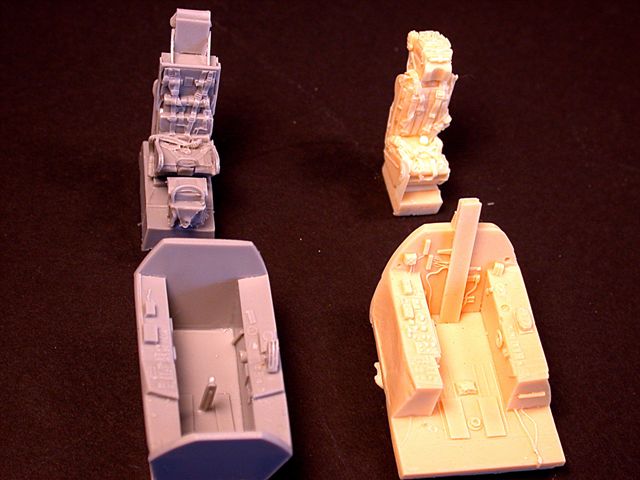
Click the thumbnails below to view larger
images:
Verdict: Dynavector/Compass Rose
Props / Spinners
CA furnishes one monolithic resin spinner (individual prop sections do
not turn) and individual injected blades. For some reason, the master
designers indexed the two prop sections so that the rear blades are
directly behind those in the front. This orientation IMO erases one of
the Wyvern's most recognized features, EIGHT BEEG BLADES! I hear
that a re-indexed spinner might be available in the future. Of course,
innovative modelers would probably carefully sever the spinner sections
and drill a hole for a prop shaft. The CA spinner is approximately 1/8"
shorter than the Compass Rose item.
Dynavector provides a multipiece spinner assembly with cast metal
blades. The Compass Rose spinner is, like that of CA, one piece with the
front and rear props once again aligned. If memory serves correctly, Roy
Sutherland then redid the spinner with staggered blades, and Lee Coll
kindly obtained one for me. At any rate, my conglomeration of parts for
the Dynavector kit has all three spinner combinations!
Verdict: Compass Rose/Dynavector by a nose
Landing Gear, Wheels and Bays
CA furnishes nicely detailed injected main and tail struts that will
need light molding seam cleanup. Resin wheel/tire assemblies are very
well done with petite hub detailing and appear to these elderly eyes to
be exact duplicates of the earlier Compass Rose ones. All three wheel
assemblies are separate from the struts. Tires are not "flattened."
Maingear and tailwheel bays are resin and finely cast, with structural
details and wiring bundles in the mains. Gear doors are injected with
minimal inner side detailing. Note that, when parked, the larger
maingear doors remain closed, so there will be very little visible bay
area here.
Dynavector's main and tail struts are cleanly cast metal, equally
detailed, and require even less cleanup. The tailwheel is cast as one
with its strut, and the separate main wheels are metal, too. The Compass
Rose wheel set furnishes new, excellent resin wheels, unflattened also.
The Compass Rose tailwheel and strut are separate. Separate maingear/tailwheel
bays are vacuformed with sharp interior panel edges but no
wiring/plumbing is represented. Gear doors are vacuformed, with no inner
side detail.
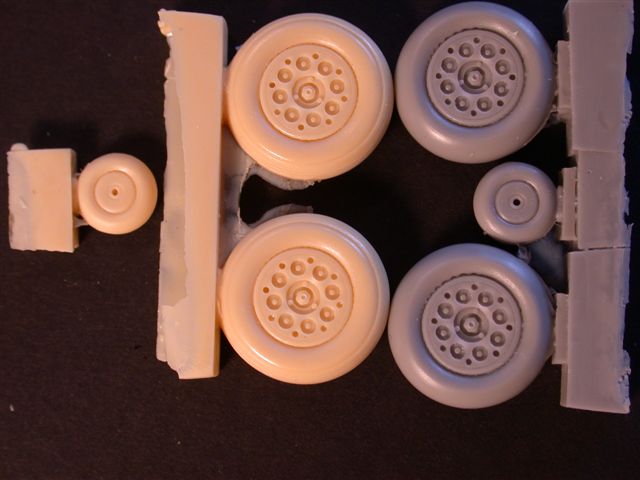
Verdict: Tossup
Fuselage
The CA effort provides two well done fuselage halves with molded-in
fairings for the large exhaust outlets. The vertical fin is a separate
piece. As mentioned before, there appear to be no locating references
for the resin tub, so trial and error is the order of the day. Also
molded in are camera windows openings (clear windows provided) aft of
the canopy. Exhaust tubes are done in resin, with beautifully petite
edges. An injected ring forms the transition between fuselage and
spinner.
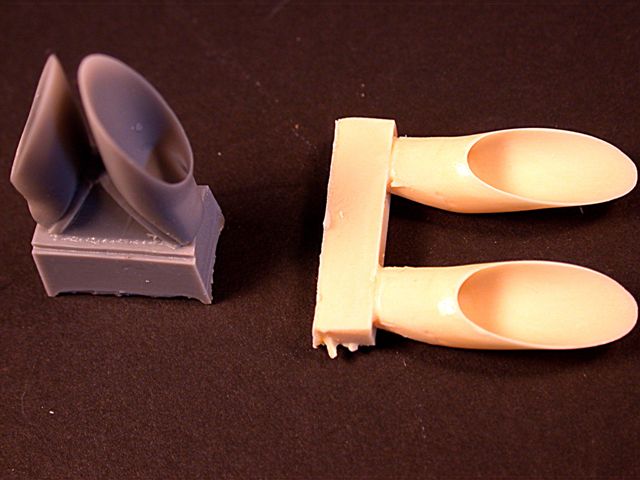
Dynavector fuselage halves are integral with halves of the prominent
vertical fin. Exhaust tube fairings are separate vac'ed parts. The
Compass Rose set replaces the metal exhaust tubes with thin resin ones
equal to those of CA. Camera openings must be cut out and clear plastic
windows fabricated, that is, unless one elects to do the old gloss
black-painted window trick! A resin ring glued to the vac fuselage is
the transition piece to the spinner of choice.
Verdict: Tossup
Wings
CA does their wings in five separate components. Chord cross sections
appear to be slimmer than those of the Dynavector kit. Dihedral is built
in to the bottom center wing section. Flying surfaces are integrated
with the main wing sections; no provision for positionable flaps or
ailerons is made. Wingfolds are not presently an option, so it's
Scratchbuild City!
The Dynavector kit does the wing in three main sections, and dihedral is
molded in to the one-piece lower wing as are the speedbrakes. Compass
Rose includes finely molded resin replacements for the speedbrakes,
including tiny actuators. Chord cross section is "fatter." Although
Dynavector makes no provision (other than scratchbuilding) for separate
flying surfaces, Compass Rose includes resin dropped flaps, outer and
inner, as well as flap lowering mechanism and wing inner structure to
receive the flaps. Airwaves produces/ed PE wingfold set AC48012 which
was designed specifically for the Dynavector kit. As mentioned above,
the CA wings appear too thin to accept these wingfold ribs.
Click the thumbnails below to view larger
images:
Verdict: Dynavector/Compass Rose
Decals
CA includes two well-printed, thin sheets (MicroScale), allowing two
different marking schemes, one for the Suez Crisis. A fair amount of
fine stencils and other panel marks top off the exercise. Red roundel
centers are separate.
The Dynavector sheet allows three marking options, but the resolution is
not as good as CA, the whites are not as white, the film is thicker and
in semigloss which is harder to hide with clearcoat. Separate roundel
red centers also appear on this sheet. Stencils are noticeably less
sharp than the CA sheet.
Click the thumbnails below to view larger
images:
Verdict: Classic Airframes
Ordnance
CA includes eight integral rocket/stub/rail assemblies; fins are also
integrated into one piece which, in turn, glues to each rocket/stub
assembly. Molding seams will need cleanup. The instruction drawings
indicate that there are mounting holes in the wings and tiny mounting
pins on each rocket stub. Not so! There are no locating pins, and the
supposed holes in the wings are, in fact, small raised dots. Since the
instructions are essentially no-text, it must be assumed that the dots
are to be sanded off, but you'll have to first drill small holes through
the dots to maintain mount locations, and if you want pins, you'll have
to add them!.
Dynavector rockets/stubs are also two-piece cast metal assemblies: the
stubs and rails are one, and the fins/rockets are one. It appears that
the cleanly cast metal will not need cleanup, and there are locating
pins on the stubs. Tiny, hard-to-see leading edge dots show where to
drill locating holes in the lower wing.
Verdict: Dynavector
Instructions
CA provides exceptionally nice perspective assembly drawings, with
mostly no-text instructions. A parts outline sheet and separate
color/markings guide tops off this fine effort. A short aircraft history
and airframe specifications fill out the cover page.
Dynavector, by virtue of being a vac kit, of necessity covers different
assembly steps than that of an injected kit. Dynavector's large,
instruction sheet, shows what needs to be shown, however, just not in as
fancy a style as the more modern CAD CA sheets. Large side and planviews
of each of the three possible aircraft are shown, as are stencil
locations.
Verdict: Tossup
Assembly Procedure
The CA Wyvern employs typical injected model assembly procedures, with
the exception that no locating pins exist, the cockpit tub must be
located by trial and error, and cyanoacrylic glue or epoxy must be used
for the resin parts. Although no aftermarket products currently exist
for this hot-off-the-presses release, most modelers will no doubt still
choose the relatively painless assembly of the CA effort. "Uncle" Jules
has hit a homerun again by actually listening and acting upon what
modelers want. Future aftermarket will, of course, push up the overall
cost of Wyvern modelling pleasure.
The much older (and more difficult to acquire) Dynavector vac kit, while
more labor intensive in the initial cutting out/sanding phase,
subsequently goes together much like injected offerings and, with its
delicate engraving, the wealth of detail provided by the Compass Rose
resin set and the Airwaves wingfolds, offers, in this curmudgeon's
opinion, superior overall "busy-ness" and detail to this most
interesting airplane.
If we were talking about the Dynavector kit alone, the Classic Airframes
Wyvern would probably be the choice for modelers who don't enjoy
"practice bleeding." But, as I've mentioned above, the Compass Rose set
added to the Airwaves wing fold makes this friendly competition between
differing modeling media a whole new ballgame.
Final Verdict? Ya pays yer money and takes yer choice.
I bought both!
Classic Airframes
kits are available worldwide through hobby retailers and from
Squadron.com
Review and Images Copyright © 2005 by
"Bondo" Phil Brandt
except Anthony Butters' Dynavector Wyvenn photo Copyright © 1996 by Pieter
Stroethoff
Page Created 20 January, 2005
Last updated 20 January, 2005
Back to HyperScale Main Page
Back to Reviews Page
|
Home | What's
New | Features
| Gallery |
Reviews | Reference
| Forum
| Search